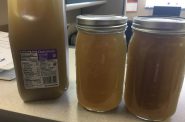Nitrate Pollutes State’s Drinking Water
Chemical is at unsafe levels in estimated 94,000 Wisconsin households.
Blue babies and birth defects
Nitrate in drinking water poses a “serious health risk to infants and pregnant women,” said Roy Irving, a state Department of Health Services toxicologist. Those who are most at risk are babies who drink formula made with nitrate-contaminated well water; breastfed infants appear to be fine even if their mothers drink polluted water.
Wisconsin’s public health officer, Henry Anderson, said his department typically finds one or two cases of blue baby syndrome per year through scanning hospital discharge and emergency-room databases.
But the department does not follow up to find out if the cases were water-related, he said, as the illness can also be triggered by medications or a rare congenital disorder. Anderson and other experts said they believed outreach by pediatricians and public health officials has been effective.

Dick Swanson of Algoma carries dolls painted blue to highlight “blue baby syndrome,” a condition caused when infants drink water polluted by nitrate. Swanson, a member of the advocacy group Kewaunee Cares, attended a “stink-in” with about 50 others on the steps of the Wisconsin State Capitol on Nov. 7 to protest pollution from concentrated animal feeding operations. Activists blame large-scale farming operations for contaminating drinking water in Kewaunee County and elsewhere. Photo by Abigail Becker of the Wisconsin Center for Investigative Journalism.
“Every visit, we ask, ‘What kind of water do you use? Do you have a well?’ ” said Dr. Beth Neary, an environmental health advocate whose longtime Madison pediatric practice included many mothers from rural areas. “But there’s got to be people who don’t go to the doctor.”
Last year, the Department of Health Services updated its health advice to warn women who may become pregnant to stay away from water with high nitrate levels, based on emerging research linking the chemical to birth defects.
In one 2013 study of 3,300 Iowa and Texas case mothers and 1,121 control mothers, those whose babies had spina bifida, cleft palate or lip, or a limb deficiency were all more likely to have drunk at least 5.4 milligrams of nitrate a day, which is under the health standard.
Some of those health effects, researchers have written, may be caused not by the nitrate itself but by contaminants, including pesticides, that often occur with it.
Dismaying statewide trend
In 2014, Masarik and a group of UW-Madison and state of Wisconsin collaborators analyzed a decade’s worth of data for more than 8,500 churches, bars and other “transient non-community water systems” that are required to test at least annually for nitrate.
They projected that given the rising or falling nitrate levels among those wells, about 687 non-community systems, or 8 percent of the total, would eventually need to invest in a new well or a treatment system.
Because nitrate can take time to make its way down to aquifers, some recent trends may be the result of land use practices from decades ago. Improvements made now may take years to bear fruit.

Kevin Masarik, a groundwater education specialist at the University of Wisconsin-Stevens Point’s Center for Watershed Science and Education, is seen here at Wisconsin Farm Technology Days near Sun Prairie in August. “I don’t think we have fully realized what the extent of nitrate (in groundwater) is throughout Wisconsin yet,” he said. Photo by Ron Seely of the Wisconsin Center for Investigative Journalism.
“I don’t think we have fully realized what the extent of nitrate is throughout Wisconsin yet,” Masarik said. “I think there’s areas where we’re going to continue to see wells exceeding the standard that maybe in the past have not been.”
Masarik described how the Joneses saw their well water creep up over 20 milligrams per liter of nitrate — twice the safe limit. Doug Jones wondered if a 15-acre field he was renting out, on which corn and soy was growing, could be to blame. Would taking land out of production improve his well water?
“I don’t know,” Masarik told Jones, offering to monitor the water.
Two years later, the nitrate levels had decreased. But, Masarik acknowledged, it is not a strategy that most well owners have the “luxury” to employ.
People always ask him: What about septic systems?
In some areas they are to blame. Human waste is rich with nitrogen, just like animal waste. Septic systems that are improperly constructed or placed in areas with vulnerable geology can lead to polluted wells.
Statewide, septics account for about 9 percent of the nitrate inputs to groundwater. Lawn care contributes another 1 percent. Artificial fertilizer and manure contribute the remaining 90 percent.
Masarik estimates that to match the water quality impact of a 20-acre field of corn, those 20 acres would have to have 36 normally functioning septic systems on them.
“Nobody really wants to think that it’s because of them,” Masarik said, but added, “If you want to have an intelligent debate about where it’s coming from and how you can fix it, it’s important to really understand the source.”
Nutrient management no fix
Fertilizer usage has about quadrupled since 1960 nationwide, according to U.S. Department of Agriculture figures. The state Department of Agriculture, Trade and Consumer Protection estimates that farmers applied over 200 million pounds of nitrogen in excess of UW-Extension crop recommendations in 2007.
Masarik said the nitrate problem is not mainly about farmers heedlessly polluting the landscape by over-applying nitrogen. The trouble is that no plant is perfect at soaking up nutrients.
The state agriculture department says nutrient management planning is one of the best ways to prevent excess nutrients from tainting the water. Wisconsin’s current standards are among the most stringent in the nation, agency spokeswoman Donna Gilson said, and revisions currently underway will require “substantially stronger restrictions” on spreading nutrients for certain soil types, in winter and near conduits to surface or groundwater.

The porous soil of Wisconsin’s Central Sands region allows manure and other fertilizers from farming operations to make their way into the aquifer, sometimes polluting the groundwater and drinking water with nitrate. Photo by Kate Golden of the Wisconsin Center for Investigative Journalism.
But state agriculture officials’ view of these plans’ effectiveness in addressing nitrate is rosier than that of groundwater experts Kraft and Masarik. Masarik, who was involved in research examining the effectiveness of such nutrient management planning, said the strategy may still result in contaminated wells unless farmers rotate their crops.
Even revisions to the nutrient management standards are unlikely to dramatically improve water quality, Masarik said. The benefits of such plans “may have been oversold in some cases — or misunderstood in terms of what’s actually realistic,” he said.
For one thing, such plans sometimes increase the use of nutrients. A survey of 259 Wisconsin farmers, most of whom grow corn and soybeans with livestock, found that 51 percent increased their nitrogen applications after implementing nutrient management planning.
Tainted Water
-
Fecal Microbes In 60% of Sampled Wells
 Jun 12th, 2017 by Coburn Dukehart
Jun 12th, 2017 by Coburn Dukehart
-
State’s Failures On Lead Pipes
 Jan 15th, 2017 by Cara Lombardo and Dee J. Hall
Jan 15th, 2017 by Cara Lombardo and Dee J. Hall
-
Lax Rules Expose Kids To Lead-Tainted Water
 Dec 19th, 2016 by Cara Lombardo and Dee J. Hall
Dec 19th, 2016 by Cara Lombardo and Dee J. Hall



















